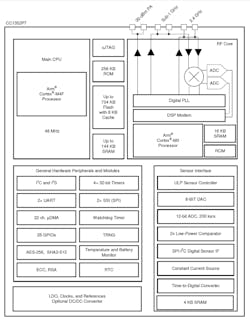Wi-SUN: A Targeted Wireless Option for IoT
Members can download this article in PDF format.
If you’re a designer of IoT networks—whether experienced or just starting out—you know that there are dozens of wireless standards and technologies to choose from. It’s a tough choice. However, if you can select a standard that’s been optimized for a specific application, your decision may be a fast and easy one.
A good example of the above is Wi-SUN, a technology developed by the Wi-SUN Alliance for implementing smart cities and smart utilities and other large, dispersed IoT networks. This standard can help speed up and simplify your design.
The IoT Concept
The whole idea of the Internet of Things is to connect a wide range of sensors and other devices to a network with internet access. With such an arrangement, all of these devices may be monitored and controlled from anywhere via the internet. Some IoT networks may be small and contained within a single building, or the nodes in the network could be very widespread. In any case, the network is designed to collect a massive amount data that’s then collected and analyzed to provide improved decision-making and benefits to the coverage area.
As the designer of such a system, you need to select an appropriate network topology. For smaller networks, the standard star topology is easy to use and set up. Big spread-out networks require a mesh topology that can provide good reliability with long-range capability. Wi-SUN technology offers that capacity.
Two good examples of Wi-SUN applications are smart cities and smart utilities or the smart grid. These networks are large and spread out, but they still must be linked into a single network. A smart-city network connects many different node types to provide useful monitoring or control functions. For instance, traffic lights, streetlights, parking facilities, environmental monitors, building access, security systems, EV chargers, and other devices can individually get attention if needed.
Smart utilities use the network to collect electrical usage from all consumer and business customers. This remote meter reading is more convenient and less costly than other methods. Utilities also can use the network to monitor remote substations or other facilities for control and fault notification. Of course, the Wi-SUN network works in homes, too. It’s a good choice for large, automated factories or anywhere many nodes are involved and widely dispersed.
Wi-SUN Overview
Wi-SUN stands for “Wireless Smart Ubiquitous Network.” It’s also sometimes referred to as the Wireless Smart Utility Network. For large Wi-SUN nets, the term field area network (FAN) is used. In general, it’s a self-forming, self-healing mesh network scalable to several thousand nodes.
The standard is developed and maintained by the Wi-SUN Alliance, an organization of users, vendors, and service providers more than 200 strong. It also serves as a certification authority that does testing of products to ensure interoperability amongst products from all vendors.
Wi-SUN technology is based on the IEEE 802-15.4g standard. As you may recall, the 802.15.4 standard is the basis for many other wireless standards, most notably Zigbee. Others include ISA100a, WirelessHART, Thread, MiWi, and 6LoWPAN. The original standard employs direct-sequence spread-spectrum (DSSS) and binary phase-shift-keying (BPSK) modulation and operates in several frequency bands at different data rates.
The most used spectrum is the 2.4-GHz license-free band, and the data rate is 250 kb/s. Alternately, the 868-MHz band (Europe) or 902- to 928-MHz band with 20 kb/s or 40 kb/s can be utilized. Typical range is about 10 meters.
Wi-SUN 802.15.4g makes further improvements. A 100-kb/s rate option was added, and four special physical-layer modulation options are available. Three of them employ DSSS using quadrature phase-shift-keying (QPSK) or offset QPSK. Multi-rate FSK, such as 2-FSK or 4-FSK, also is commonly used. Amplitude shift keying (ASK) is available as well.
Wi-SUN adds a frequency-hopping feature that helps reduce interference from other nearby sources and improve overall network reliability. Access methods include carrier-sense multiple access/collision detection (CSMA/CA) and time-division multiple access (TDMA). A power increase to +30 dBm helps extend the useful range up to 4 km or more depending on the terrain.
A key aspect of the Wi-SUN standard is the availability of 6LoWPAN. This is the header compression standard that allows for the use of 128-bit IPv6 internet addresses to accommodate very large networks. Another feature is the standard’s security capability. It offers a public key infrastructure (PKI), full data encryption, and certificate-based authentication.
Wi-SUN only defines the physical (PHY) and media-access-control (MAC) layers in the protocol stack. You must build or acquire the upper layers of the stack for your application. Designing your own stack can be a daunting and time-consuming task. To avoid this problem, be sure your semiconductor vendor is able to provide a stack for the chosen devices.
Implementing Wi-SUN
Texas Instruments is one vendor that can supply Wi-SUN-capable transceivers and processors. For instance, the CC1200 is a low-power <1-GHz radio that can operate in the 169, 433, 868, 915, and 920 bands. It can handle data rates to 1.25 Mb/s. Output power can be up to +16 dBm and receiver sensitivity is −109 dBm at 50 kb/s. In power-down mode, the current is 0.12 µA.
Two additional devices combine the radio and the MCU. The CC1312R includes an Arm Cortex-M4F processor plus plenty of RAM and flash. It’s designed for the <1-GHz bands. The CC1352P7 operates in the < 1-GHz bands, too, as well as the 2.4 GHz band. Both devices offer multiple RAM/flash options to fit your design. In addition, TI offers numerous software-development kits along with other support.


